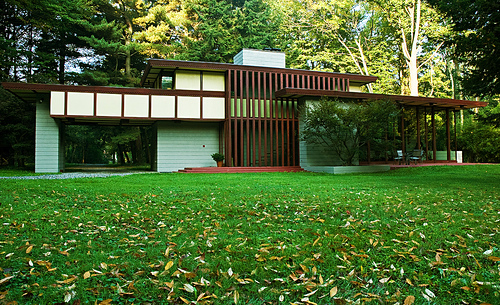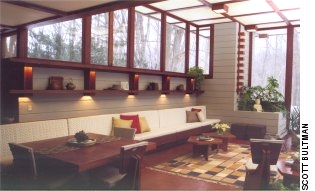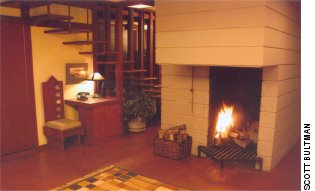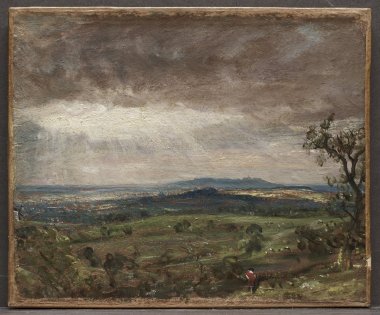“To me wherever you go–even behind the Iron Curtain–it’s just another city,” Louis Armstrong told a reporter in 1966. “All hotels are alike–bed, bureau, two pillows.” I know what he meant, and now that I spend so much time on the road reviewing regional theater for The Wall Street Journal, I escape the terrible sameness of hotel life by staying in bed-and-breakfast inns as often as I can. I love the unassuming comfort that these homes-away-from-home afford, but the gingham-and-frills décor favored by most innkeepers isn’t my style–I’m a confirmed midcentury modernist–and from time to time I feel the need to do something completely different.
 Usually that means holing up for a night or two in an ultra-modern big-city high-rise hotel, and under normal circumstances that’s what I would have done when I went to Cleveland last week to visit the Great Lakes Theater Festival and the Cleveland Play House. It happened, though, that the only performances of the Great Lakes Theater Festival’s productions of Macbeth and Into the Woods that I could stuff into my schedule took place last Sunday and Wednesday, meaning that I’d have to spend four nights in town instead of my usual two. So instead of staying in the theater district of Cleveland, Mrs. T and I spent the better part of a week at the Penfield House, a half-century-old home designed by Frank Lloyd Wright, and turned a business trip into a retreat.
Usually that means holing up for a night or two in an ultra-modern big-city high-rise hotel, and under normal circumstances that’s what I would have done when I went to Cleveland last week to visit the Great Lakes Theater Festival and the Cleveland Play House. It happened, though, that the only performances of the Great Lakes Theater Festival’s productions of Macbeth and Into the Woods that I could stuff into my schedule took place last Sunday and Wednesday, meaning that I’d have to spend four nights in town instead of my usual two. So instead of staying in the theater district of Cleveland, Mrs. T and I spent the better part of a week at the Penfield House, a half-century-old home designed by Frank Lloyd Wright, and turned a business trip into a retreat.
The Penfield House is one of six Wright-designed houses that can be rented on a short-term basis. It’s located in Willoughby, a quiet suburb east of downtown Cleveland. The house isn’t visible from the road–it’s in the middle of thirty acres of heavily wooded land–and you have to look closely to spot the Cherokee-red gate which tells you that you’ve gotten where you’re going. You push open the gate and drive down the gravel road, and all at once the house comes quietly into view, a simple two-story home built out of glass, wooden beams, concrete blocks, and light tan asbestos-and-concrete panels.
 Like all of Wright’s Usonian houses, the Penfield House seems to melt into the landscape rather than dominating it. As you pass through the unostentatious entrance, you feel as though you’re still out of doors, for one of the walls of the twelve-foot-high living room is made almost entirely of glass, and the ceiling and floor extend beyond the glass wall in such a way as to create the illusion that the house is wide open to the surrounding woodland. The Chagrin River is nearby, and Paul Penfield, the owner, has cut a trail through the woods, making it possible for guests to wander at their leisure. Even though the house is only twenty minutes from downtown Cleveland, the city feels as though it’s on the far side of the world. One afternoon I sat in the living room watching the leaves fall, and a half-dozen deer sauntered through the yard as though I didn’t exist.
Like all of Wright’s Usonian houses, the Penfield House seems to melt into the landscape rather than dominating it. As you pass through the unostentatious entrance, you feel as though you’re still out of doors, for one of the walls of the twelve-foot-high living room is made almost entirely of glass, and the ceiling and floor extend beyond the glass wall in such a way as to create the illusion that the house is wide open to the surrounding woodland. The Chagrin River is nearby, and Paul Penfield, the owner, has cut a trail through the woods, making it possible for guests to wander at their leisure. Even though the house is only twenty minutes from downtown Cleveland, the city feels as though it’s on the far side of the world. One afternoon I sat in the living room watching the leaves fall, and a half-dozen deer sauntered through the yard as though I didn’t exist.
The sense of removal from the encroaching world is heightened by the fact that you can’t surf the Web in the Penfield House. During my stay there, I checked my e-mail once a day by driving a mile to the parking lot of a Wendy’s that had free wireless service. Otherwise I was out of touch, and glad to be. Instead of keeping up with current events, I read two new books from cover to cover, Brad Gooch’s forthcoming biography of Flannery O’Connor and John Lucas’ Thomas Beecham: An Obsession With Music, and listened to Stravinsky’s Apollo and Symphonies of Wind Instruments, the Copland Piano Sonata, Julian Bream’s recording of Lennox Berkeley’s Guitar Sonatina, and a Beethoven string quartet. The house has a TV, but we never bothered to turn it on.
At night we drove into the city to dine and see shows, but we came back to the house as soon as we were done, for we knew within minutes of our arrival on Sunday that we’d want to spend as much time there as possible. Since both theaters were dark on Monday, Mrs. T and I spent the whole day and night at the house, leaving only long enough to buy groceries. After dinner we turned on all the lights, went outside, and marveled at its warm, unassuming beauty. Even though the Penfield House is a work of art in and of itself, Paul and his wife Donna have gone to considerable trouble to make it look and feel like a home, not a museum. I’ve never stayed in a more comfortable place, or a more soothing one.
 Some part of this comfort, I know, arose less from the house than from the circumstances of our staying there. To spend four days in a Web-free woodland retreat could scarcely fail to please an Upper West Side writer who lives in the middle of the hum and buzz of urban culture. But it wouldn’t have been the same had we stayed in a log cabin or a McMansion, for the all-pervading orderliness of the grid that Wright used to generate the floor plan and architectural detail of the Penfield House is both relaxing and reassuring to the eye. Modern the house most definitely is, but not in the hectoring manner of the International Style. It is, above all, tranquil, a point of repose in a world of pandemonium, a place where you can hear yourself think–or, if you like, where you can think of nothing at all. Wallace Stevens wrote a poem called “Not Ideas About the Thing but the Thing Itself.” Such self-sufficient things were the stuff of which our four days at Penfield House were made: falling leaves, train whistles in the distance, deer on the lawn, rain on the roof.
Some part of this comfort, I know, arose less from the house than from the circumstances of our staying there. To spend four days in a Web-free woodland retreat could scarcely fail to please an Upper West Side writer who lives in the middle of the hum and buzz of urban culture. But it wouldn’t have been the same had we stayed in a log cabin or a McMansion, for the all-pervading orderliness of the grid that Wright used to generate the floor plan and architectural detail of the Penfield House is both relaxing and reassuring to the eye. Modern the house most definitely is, but not in the hectoring manner of the International Style. It is, above all, tranquil, a point of repose in a world of pandemonium, a place where you can hear yourself think–or, if you like, where you can think of nothing at all. Wallace Stevens wrote a poem called “Not Ideas About the Thing but the Thing Itself.” Such self-sufficient things were the stuff of which our four days at Penfield House were made: falling leaves, train whistles in the distance, deer on the lawn, rain on the roof.
On Tuesday morning I rose early, went downstairs, and wrote a drama column for The Wall Street Journal. I sat at the kitchen table, listening to the birds singing outside the house, and thought to myself, I could write a book here. The piece came easily, and by noon I’d driven to Wendy’s, e-mailed it to New York, and returned home–for by then Hilary and I both thought of the Penfield House as our home. That day was the first anniversary of our marriage, and we celebrated in style, eating a flawlessly served champagne dinner at Stages, the onsite bistro of the Cleveland Play House, then strolling down the hall to see Michael Frayn’s Noises Off, the funniest play ever written. I’d added it to my schedule partly because I’d never seen the company and partly because Mrs. T had never seen the play. You couldn’t have asked for a more festive evening. Still, the best part was when we drove back to the Penfield House, unlocked the gate, and put the world behind us again.
 We left on Thursday morning with the utmost reluctance, easing the pain of our going by paying a visit to the Cleveland Museum of Art en route to the airport. It is, to be sure, a very great museum, just as our life in New York and Connecticut is an unmixed blessing, and we rejoiced in seeing such masterpieces as John Constable’s “Hampstead Heath, Looking Toward Harrow,” an exquisite little oil on paper that I longed to show off to Our Girl, who is responsible for having gotten me excited about Constable in the first place. Yet all that Mrs. T and I could talk about on the flight home was how much we looked forward to our next trip to Cleveland. May it come soon.
We left on Thursday morning with the utmost reluctance, easing the pain of our going by paying a visit to the Cleveland Museum of Art en route to the airport. It is, to be sure, a very great museum, just as our life in New York and Connecticut is an unmixed blessing, and we rejoiced in seeing such masterpieces as John Constable’s “Hampstead Heath, Looking Toward Harrow,” an exquisite little oil on paper that I longed to show off to Our Girl, who is responsible for having gotten me excited about Constable in the first place. Yet all that Mrs. T and I could talk about on the flight home was how much we looked forward to our next trip to Cleveland. May it come soon.
